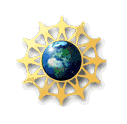|
In MATLAB .
. . . . . .

Superconics Animation
Code
|
|
Why
Superconics?
Cye H. Waldman
There is a plethora of super
this-and-that running around the
mathematical world these days:
superellipse (and its 3D cousin,
superquadrics), supercircle,
superparabola, superhyperbola, and
superformula. So why do we need
superconics?
Superconics is a system of curves,
based on the conic sections, for two
and three-dimensional shapes. With
the exception of the superformula,
all of the above are subsets of
superconics. In one equation,
superconics describes all of these
and more. Moreover, it is amenable
to exact mathematical analysis.
Specifically, a single analytic
solution gives the area, centroid,
moments, and volume of bodies of
revolution over the wide range of
variables embraced by superconics.
Superconics provides a systematic
set of functions for evaluation of
various problems. This has allowed
us to extract certain mathematical
relations that may have gone
unnoticed heretofore.
Superconics is essentially a
two-parameter function, with one
additional switch that distinguishes
elliptic/parabolic and hyperbolic
types. Extended superconics is a
three-parameter function that
provides the full spectrum of curves
between and beyond elliptic and
hyperbolic types. This function
completely blurs the distinction
between the two types; you can
transition smoothly between them.
The extended superconics likewise
has a completely analytic solution.
As for the superformula, it’s merely
an elaborate curve-fitting equation
with four parameters in addition to
axial scaling, cleverly guised in
mathematical notation. There are no
mathematical properties, per se,
because it’s intractable. Its
properties can only be determined by
direct numerical simulation; but
then it’s doubtful that any of its
acolytes has ever looked.
In our studies of superconics we
have come to develop new
understandings that can be readily
ported to other areas of interest.
In the mathematical arena, we have
demonstrated new relations between
volume and centroid and the plane
curves that generate them.
In our studies of superconics in
three dimensions, we have developed
an algorithm for 3D shapes that allow
the
generating curve (or vertical
profile) to vary continuously while
tracing out the base curve.
And that is why
superconics.
|

Superparabola

A sampler of curves in
the superparabola
family. Note the
pulse for large
values of p.
We define
superparabola as a
parabola raised to
a positive power
greater than or equal
to zero.
Example:
|

Superellipse
 A
sampler of curves in the
superellipse
family. Note the
cusp for small
values of p.
A
sampler of curves in the
superellipse
family. Note the
cusp for small
values of p.
The superellipse, also
known as the Lamé
curve, is used in the
following form for the
cylinder footprint:
|
|
Superconics:
Hyperspheroid

and the
equations . . .
. .
|

Another Version of
a Superconics
Hyperspheroid

|
|
Methods:
Writing the Program
All
3D figures and
animations were created
with a program developed
by the authors. The crux
of the program is the
spherical product
routine that is
essentially the product
of a matrix and a
diagonal matrix. The
input parameters are an
n-by-n matrix (n-by-n
column vectors for the
vertical ribs) and an
n-vector (the planiform
curve). These are
as expressed complex
variables; in the
matrix, the real and
imaginary parts are the
radial and vertical
components of the
vertical ribs,
respectively.
In
the main program, the
n-by-n matrix is
calculated sequentially
around the planiform
based on the local
vertical profile. All
the vertical profiles
are superconics, but the
need not be. Toroids and
Mobioids can be created
with a few control
parameter settings. And
the same program applies
to the extended
superconics with 3
parameters or complex
parameters.
We
have used the same
program to create 3D
forms from regular and
star polygons, cuspids
and rosettes, Reuleaux
triangles,
superformulas, and more,
even fractals (imagine a
Koch snowball created
form Koch snowflake).
Moreover, any of these
forms can be mixed and
matched; the program
does not care.
In
addition, we have used
the same program, albeit
with some ad hoc
modifications to create
twisted cylinders, the
Archimedean hoof,
sphericon, tractroid,
and more.
|
Copyright
Notice: The
animations and all images within
are under copyright by Cye Waldman
and may not be copied,
electronically or otherise,
without his express permission.
Dr. Cye
Waldman, cye@att.net
|
|
|
 2017
2017 |
|
|
|


